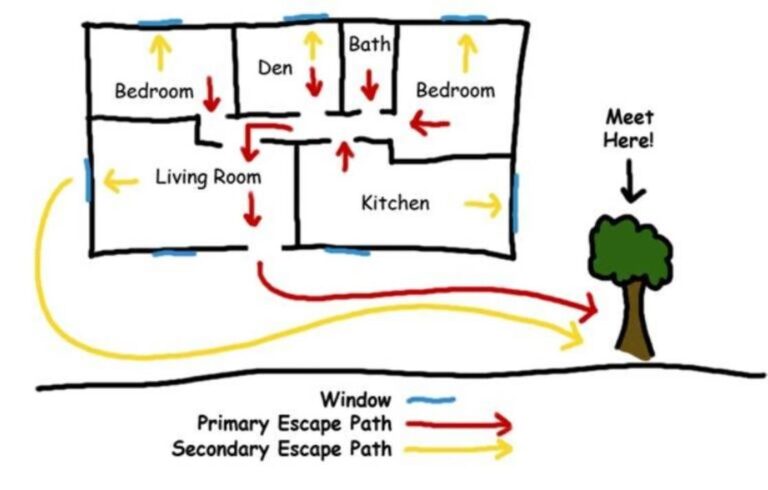Table of Contents
- Assessing Potential Home Hazards and Risk Factors
- Designing Effective Communication Strategies for Emergencies
- Essential Supplies and Equipment for Your Safety Kit
- Creating and Practicing Evacuation and Shelter-in-Place Plans
- In Conclusion
Assessing Potential Home Hazards and Risk Factors
Before developing a robust emergency safety plan, it’s essential to identify the specific hazards that lurk within your home environment. Start by conducting a thorough walkthrough of each room, looking for anything that could pose a threat during an emergency. Pay special attention to potential fire hazards such as overloaded power outlets, faulty wiring, or the presence of flammable materials near heat sources. Additionally, assess structural vulnerabilities like cracked walls, loose railings, or unstable shelving that could become dangerous during natural disasters like earthquakes or severe storms.
Beyond physical dangers, consider everyday risk factors that might increase vulnerability during emergencies. These include inadequate lighting in hallways and exits, which can hinder safe evacuation, or lack of accessible emergency supplies like first aid kits and flashlights. Compile your findings into a clear list that highlights areas needing immediate action. For instance:
- Unsecured heavy furniture that can topple
- Blocked or cluttered escape routes
- Absence of smoke and carbon monoxide detectors
- Improper storage of hazardous chemicals or medications
Identifying these risks early allows you to prioritize fixes and tailor your safety plan to the unique challenges within your home, ensuring peace of mind and enhanced protection for you and your loved ones.
Designing Effective Communication Strategies for Emergencies
Effective communication during an emergency is vital to ensuring the safety and well-being of all family members. Begin by establishing clear roles and responsibilities for each person in the household, so that everyone knows who is in charge of what task. This clarity reduces confusion and allows for swift, organized action. Use a combination of traditional and modern communication tools such as landlines, mobile phones, text messaging, and emergency apps to maintain contact under various circumstances. It’s essential to agree on a set of emergency codes or signals that can quickly convey critical information without panic.
Additionally, a well-thought-out communication strategy involves identifying a reliable out-of-town contact. This person serves as a centralized point of information, especially if local lines become overwhelmed. Keep a printed list of emergency contacts, including neighbors, local emergency services, and medical providers, accessible to all family members. Reinforce the importance of checking in at regular intervals and practicing the communication plan through drills-this helps everyone stay calm and confident when an actual emergency occurs. By integrating these communication elements, your home emergency safety plan becomes a cohesive system designed to protect and guide your family when it matters most.
Essential Supplies and Equipment for Your Safety Kit
When assembling your safety kit, prioritize items that cover the basics of survival: water, food, and first aid. Stock at least a three-day supply of bottled water-one gallon per person per day is ideal. Non-perishable foods like canned goods, energy bars, and dried fruits ensure you have nourishing options during an emergency. Don’t forget essentials like a manual can opener and disposable utensils to make mealtime manageable under adverse conditions. Your kit should also include a comprehensive first aid kit, complete with bandages, antiseptics, and any prescribed medications, as well as a multipurpose tool to assist with unexpected repairs or tasks.
Additional must-haves enhance both safety and communication. A reliable flashlight with extra batteries can provide critical illumination when power is out, while a battery-powered or hand-crank radio keeps you informed with emergency broadcasts. Personal hygiene supplies, such as moist towelettes, garbage bags, and disinfectants, help maintain cleanliness and prevent illness. Finally, include important documents sealed in waterproof bags, emergency contact lists, and cash in small denominations. By carefully selecting these supplies, your safety kit becomes a robust foundation that supports you and your family when it matters most.
Creating and Practicing Evacuation and Shelter-in-Place Plans
Formulating detailed evacuation and shelter-in-place protocols is essential to ensure every family member knows exactly what to do during an emergency. Start by mapping out multiple exit routes from your home and neighborhood so that if one path is blocked, alternative routes are available. Designate specific meeting points both inside the house and outside in the community to gather safely. Make sure these plans are tailored to accommodate all household members, including pets, elderly relatives, and those with special needs. Utilize clear and concise communication methods to convey steps and responsibilities, ensuring no confusion when seconds count.
Once your plan is drafted, the true value lies in regular practice. Schedule bi-annual drills to reinforce the procedures, using realistic scenarios to simulate potential emergencies such as fires, chemical spills, or severe weather conditions. During drills, pay attention to response times and adherence to the plan, and adjust it accordingly based on any challenges encountered. Encourage questions and discussions afterward to improve understanding and commitment. Remember, consistent practice transforms plans into instinctual actions, significantly increasing your family’s safety and confidence under pressure.
- Identify multiple escape routes and safe meeting spots.
- Communicate the plan clearly to all household members.
- Practice drills at least twice a year for readiness.
In Conclusion
Creating a comprehensive home emergency safety plan is more than just a precaution-it’s a vital step in protecting your loved ones and your property. By taking the time to assess potential risks, establish clear communication strategies, and prepare essential supplies, you can face unexpected situations with confidence and peace of mind. Remember, the key to an effective plan is regular review and practice, ensuring everyone in your household knows exactly what to do when seconds count. Start building your safety plan today, and turn preparedness into your family’s greatest strength.Check Our Other Blogs
- StunGun – Your Trusted Source for Stun Guns, Laws, and Self-Defense Tips
- PepperSprayLaws – Your Trusted Resource for Pepper Spray Information
- StunGunLaws – Your Trusted Guide to Stun Gun Legality and Safety



